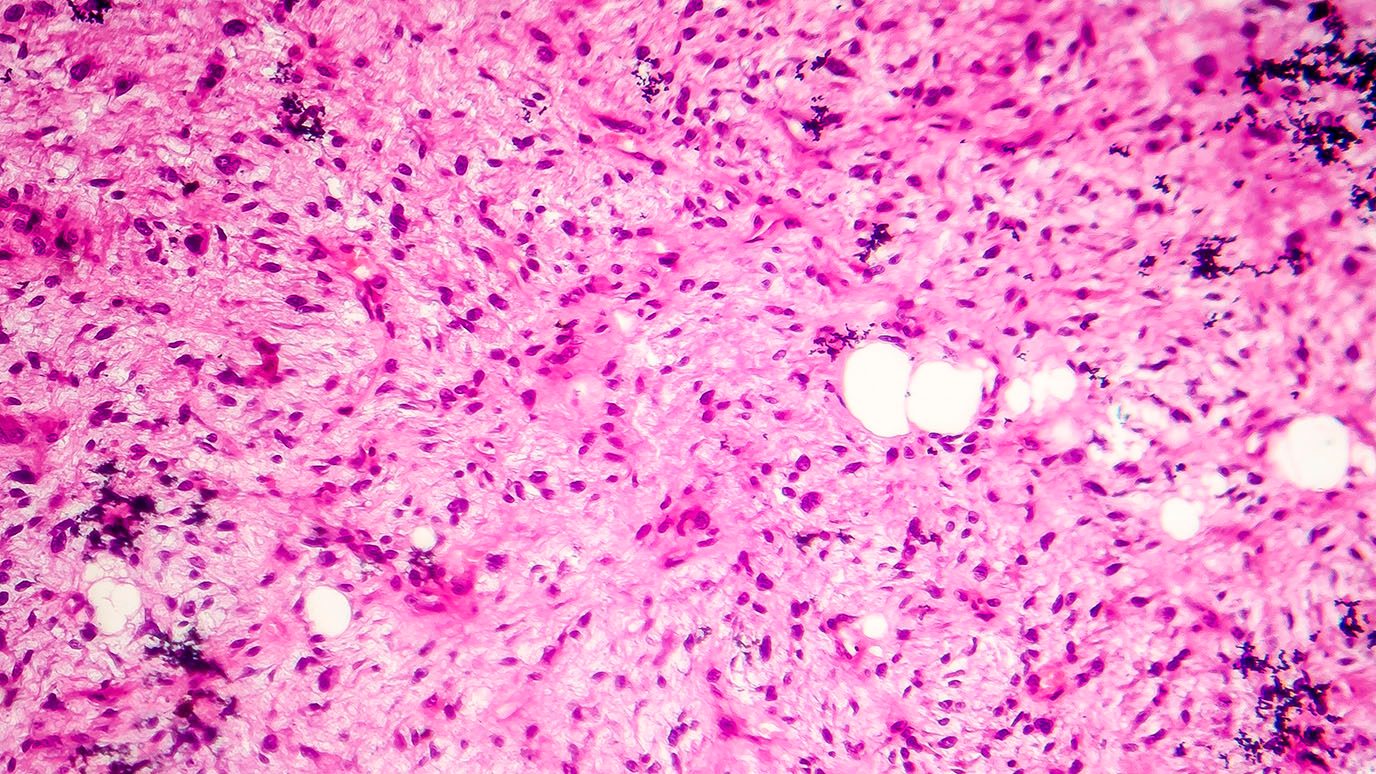request an appointment online.
- Diagnosis & Treatment
- Cancer Types
- Soft Tissue Sarcoma
Get details about our clinical trials that are currently enrolling patients.
View Clinical TrialsSoft tissue sarcomas are group of cancers that typically develop in the soft tissues surrounding, connecting or supporting the body’s structures and organs. These tissues includes muscles, joints, tendons, fat, blood vessels, nerves and tissues.
Soft tissue sarcomas are group of cancers that typically develop in the soft tissues surrounding, connecting or supporting the body’s structures and organs. These tissues includes muscles, joints, tendons, fat, blood vessels, nerves and tissues.
Some soft-tissue tumors, such as lipomas and hemangiomas, are benign (not cancer). Others are malignant (cancer) and are called soft tissue sarcomas. There are more than 30 types of sarcoma, making each extremely rare. Sarcomas are classified into groups that have similar types of cancer cells and symptoms. They usually are named for the type of tissue where they start. Sarcomas within a classification often are treated the same way.
The main types of soft-tissue sarcoma begin in:
- Muscle tissue
- Peripheral nerve tissue
- Joint tissue
- Blood and lymph vessels
- Fibrous tissue
- The connective tissue of the breast, in the form of phyllodes tumors and other soft tissue sarcomas.
Sarcomas of uncertain tissue type: In this type of sarcoma, doctors are not able to determine the exact type of tissue where the cancer began.
Soft Tissue Sarcoma Risk Factors
Anything that increases your chance of getting cancer is a risk factor. For sarcoma, risk factors include:
Inherited genetic conditions such as:
- Von Recklinghausen disease
- Li-Fraumeni syndrome
- Gardner syndrome
- Inherited retinoblastoma
- Werner syndrome
- Gorlin syndrome
- Tuberous sclerosis
Other risk factors include:
- Damage or removal of lymph nodes during previous cancer treatments.
- Exposure to vinyl chloride, a chemical used in making plastics.
- Previous radiation treatment for another cancer.
Not everyone with risk factors gets sarcoma. However, if you have risk factors, it’s a good idea to discuss them with your health care provider.
Learn more about soft tissue sarcoma:
Some cases of soft tissue sarcoma can be passed down from one generation to the next. Genetic counseling may be right for you. Learn more about the risk to you and your family on our genetic testing page.

MD Anderson is #1 in Cancer Care
Orthopedic oncologist passionate about helping patients...
Why choose MD Anderson for soft tissue sarcoma treatment?
MD Anderson's Sarcoma Center features one of the few medical teams in the world devoted to soft-tissue sarcomas. Our experts customize your care to deliver the most successful treatment, while focusing on your quality of life.
We see more sarcoma patients in a day than many cancer centers do in a year. This gives us a level of expertise and experience that can make a difference in your outcome.
Diagnosis of sarcomas can be challenging, but accurate diagnosis is essential to successful treatment. In fact, having an inaccurate or unsuccessful biopsy can be harmful. Our pathologists are dedicated to sarcoma, and they use the latest, most-sophisticated tests to pinpoint the type and extent of the cancer.
Comprehensive Care, Innovative Research
Using a team approach that brings together specialists from many areas, we offer everything you need for diagnosis and treatment in one location. Our treatments draw upon the latest technology to save limbs, as well as function and appearance.
As one of the world's leading sarcoma research centers, we helped pioneer many advancements used around the world, including:
- New ways to combine therapies, including surgery, chemotherapy or radiation therapy, to be more successful
- Advanced chemotherapy agents and novel delivery methods that have less impact on the body
- Limb-sparing surgery that can help preserve arms and legs in many cases
- Medicines to fight cancer on a molecular level
- Ways to deliver more intense chemotherapy
Every MD Anderson surgeon and oncologist we met was great. We felt comfortable and confident that we were in good hands both before and after surgery.
Leticia Rousseve
Caregiver
Treatment at MD Anderson

Featured Articles

Understanding adult rhabdomyosarcoma: Types, prognosis and...

Gastrointestinal stromal tumors (GISTs): What are they, and how...

Newest research in sarcoma

Young adult cancer survivor’s treatment sparks passion for...

Pleiomorphic sarcoma survivor: MD Anderson gave me back my life

Updates in soft tissue sarcoma

Soft tissue sarcoma survivor’s trust in her care team was vital...

Sarcoma relapse survivor: MD Anderson gave me a second chance to...
Clinical Trials
MD Anderson patients have access to clinical trials offering promising new treatments that cannot be found anywhere else.
Becoming Our Patient
Get information on patient appointments, insurance and billing, and directions to and around MD Anderson.
myCancerConnection
Talk to someone who shares your cancer diagnosis and be matched with a survivor.
Prevention & Screening
Many cancers can be prevented with lifestyle changes and regular screening.
Counseling
MD Anderson has licensed social workers to help patients, family members and loved ones cope with cancer.
Help #EndCancer
Give Now
Donate Blood
Our patients depend on blood and platelet donations.
Shop MD Anderson
Show your support for our mission through branded merchandise.

